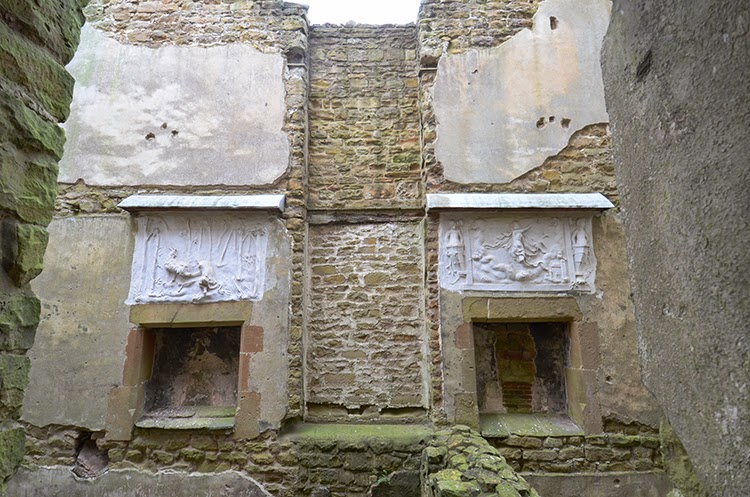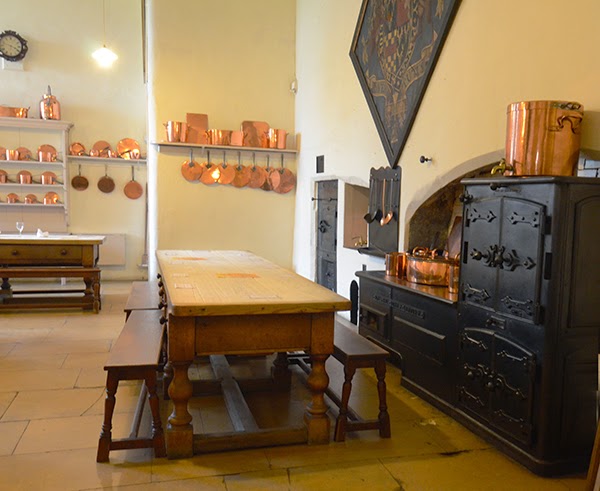Elizabeth Hardwick, painted 1550 (born 1520 to 27, died 1608)
Elizabeth Hardwick was born in the early 16th century –– a contemporary of Elizabeth 1st and definitely cut from the same fierce cloth. Although her beginnings were modest, 4 brilliant marriages increased her stature exponentially. She became enormously wealthy, powerful and respected –– with a brilliant mind and indomitable will –– she even defied Queen Elizabeth and got away with it. She was quite a dame.
I have felt drawn to her for many years, probably because she loved architecture and impressed her love of light upon the builders and architects of her houses to such a degree that it inspired a rhyme about Hardwick house, “Hardwick Hall - more glass than wall.” The lady certainly had the wherewithal to see her original designs realized. I've always wanted to see the hall in person.
I finally got to cross Hardwick Hall off my bucket list.
I had known about Hardwick Hall for eons but was surprised to discover Old Hardwick in noble ruins beside the new hall. I was in love.
Bess's very individual ideas about houses can even be seen in the ruins of Old Hardwick. She decided to place the reception rooms (the most grand spaces in the hall) on the top floor instead of following the traditional plan that put the reception rooms on the ground floor –– 'tis better to see England's emerald vistas from a lofty perch.
The lush countryside was easy to view through the large windows. In a way, Hardwick Old Hall was a dry run for the new hall, but only just. Bess had been born in a small medieval house on the property, but she tore it down and started over in 1587, just a few years before employing Robert Smythson to build her “Prodigy House” in 1590 right next to it (a prodigy house was a grand place meant to impress visiting kings and queens on their progresses (both an honor and a curse, the trips could empty the coffers of gentry who had gotten a bit to big for their britches –– long stays were ruinously expensive). Smythson was an excellent choice for New Hardwick. He was a master mason on Longleat (you can read about it HERE) who had been bumped up to the category of “surveyor” or “architecter” by the time he built divine Wollaton House –– he was much in fashion by the time he worked at Hardwick.
Old and New Hardwick Hall were both fully engaged to entertain large parties during Bess's time.
16th c Spanish leather (Shoe & Leather Museum) from Surface Pattern Design
New Hardwick is grander but the remaining lineaments of the old hall (and remarkably detailed household inventories of Bess’s time) show a house of great elegance and charm filled with tapestries and an uncommon amount of tooled leather hangings. Many of the of the old house's fine contents were deployed to various family properties when the old house was no longer habitated. It did have a second life as a ruin. Trees were actually planted inside the house amidst crumbling floors. It was a fashion in the 18th and 19th century to have a ruin (known as a folly) on your property –– neither ancient crumbling abbey, Norman castle or faux classical Temple as was the fashion, Hardwick Old Hall was an unusual folly as is stood next to a house that was the same vintage as the ruin.
Now missing most floors and open to the skies, small lead 'roofs' offer some protection for the plasterwork that has been limed to show up white as could be.
There is even the ghost of the great kitchen with giant fireplaces and ovens. How I wish I could have seen it in its prime.
You can definitely see what it might have been when you look at the great kitchen of the new hall
The furniture is 19th century
Modern cast iron stoves replaced the great fireplaces in the 19th century –– although some of the earlier ovens and cooking surfaces remain on the right, and a turnspit hangs over the oven as a reminder.
Glowing copper replaced the old Tudor era pots and pans.
Of course there’s the famous view with the amazing windows and Bess’s initials carved rather proudly like alphabet crowns. When she entertained on the roof (as was the fashion of the day), it must have had quite an effect on the guests.
There were brilliant receiving rooms like the High Great Chamber with the captivating huntress Diana holding court in the forest frieze that circles the room.
Detail of Frieze (Country Life Magazine)
The great long gallery is the largest surviving Elizabethan example of the form –– 51 meters (167’) long and still decorated with mostly original hangings.
A 19th century addition of a fun but wildly overdone late 17th century State Bed tester adds a bit of drama.
The Sea Dog table -- thought to be one of the most important Elizabethan pieces to survive to the present – pictures do not do it justice – takes your breath away.
Then there are the beds, here are just a few of them ––
The cut velvet dressing room
The blue room
My favorite was the green velvet room
Dining Room
Admittedly, the dining room was a bit of a letdown. It is fine in its own way, but the 18th century furnishings lack the strength of the furniture from Bess’s time when great massive tables would have been set in the more grandly proportioned rooms. This just felt mismatched and wrong. Bess came before the idea of a separate dining room had become fashionable.
I had to think more “Great Hall” than the motley Hardwick dining room as I pondered my favorite question, what did they eat?
Bess, 1580
As the New Hall was built between 1590 and 1592, I thought something from Bess’s time would be appropriate. Since she lived to a vibrant 80 or more (her birth date was not certain – anything from 1520-27), I thought she must have enjoyed good healthy food to keep up with the demands of running so many households (Hardwick, Chatsworth, Sheffield Manor, Tutbury Castle and Wingfield Manor).
The Good Housewife’s Jewel was written in 1596 by Thomas Dawson and it’s full of great recipes for vegetables, stews and pies as well as desserts (although they were part of the dinner and not thought to be a final course at that time). It seemed a great resource for Bess's nosh.
It was hard to choose between an almond broth stew, oyster pie and spinach fritters but spinach won the day. I imagine Bess, pouring over plans whilst popping a few of these dainties for sustenance -- washed down with a good English ale.
To make Fritters of Spinnedge.
Take a good deale of Spinnedge, and washe it cleane, then boyle it in faire water, and when it is boyled, then take it forth and let the water runne from it, then chopit with the backe of a knife, and then put in some egges and grated Bread, and season it with suger, sinamon, ginger, and pepper, dates minced fine, and currans, and rowle them like a ball, and dippe them in Batter made of Ale and flower
I was fortunate that I did not have to develop a recipe this time -- wrangling measurements out of the barest hints of proportions in the 1596 description of the dish can be trying and time consuming. Lucky for me, the brilliant Mark Melton, food historian at Hampton Court (that I wrote about HERE) had already done the legwork and Christine Muelke of the NYTs had published it in 2006.
They are addictive, delicious and surprising. The spinach sort of dissolves into a greenness and they taste a bit like a donut with a warm, spicy filling.
Spinach and Date Fritters (Adapted from Hampton Court Palace.)
8 ounces spinach
3 large eggs, beaten until smooth
½ teaspoon salt
¼ teaspoon freshly ground black pepper (I added a bit more pepper)
½ teaspoon ground ginger
¼ teaspoon ground cinnamon
4 ounces (about 20 medium) pitted dates
2 ounces (scant ½ cup) currants
½ cup fine dry bread crumbs, or more as needed
Vegetable oil, for frying
1 cup all-purpose flour
1 cup beer
Confectioners' sugar, for dusting.
1. Bring a large pot of water to a boil and add the spinach. Cook until thoroughly wilted, then drain well in a colander and cool. (I was very naughty and didn't cook it at all –– I squeezed the water out
after chopping).
2. Squeeze out as much water as possible and transfer spinach to a cutting board. Using the back of a large knife, pound the spinach repeatedly to break down the fibers in the stalks and leaves. When the spinach has a mashed appearance, chop coarsely. Transfer to a large bowl. Add the eggs and mix well. Stir in the salt, pepper, ginger and cinnamon.
3. Using a food processor, or by hand, finely chop the dates and currants. Add to the spinach mixture and stir until blended. Mix in ð cup bread crumbs and allow to sit for 2 to 3 minutes. The mixture should be thick enough to shape into balls about 1 ¼ inches in diameter. If necessary, add more bread crumbs to obtain the right consistency.
Make 24 balls.
4. Place a wide, deep pan over medium heat and add enough oil to come about 1 ½ inches up the side of the pan. Meanwhile, in a small bowl, make a batter by mixing together the flour and beer, stirring until very smooth.
5. When the oil is shimmering, dip a spinach ball in the batter, allowing any excess to drip off. Place the ball in the oil. It should begin to fry immediately, turning light golden brown in 1 to 2 minutes. Remove and drain on paper towels. Repeat with the remaining balls and batter, adjusting heat as necessary. Dust with confectioners' sugar and serve hot.
Makes 24 fritters.
I'm off doing 2 episodes of a TV series (1960's crimes-fun!). Will try to be do a blog every few weeks and not be gone so long!
2. Squeeze out as much water as possible and transfer spinach to a cutting board. Using the back of a large knife, pound the spinach repeatedly to break down the fibers in the stalks and leaves. When the spinach has a mashed appearance, chop coarsely. Transfer to a large bowl. Add the eggs and mix well. Stir in the salt, pepper, ginger and cinnamon.
3. Using a food processor, or by hand, finely chop the dates and currants. Add to the spinach mixture and stir until blended. Mix in ð cup bread crumbs and allow to sit for 2 to 3 minutes. The mixture should be thick enough to shape into balls about 1 ¼ inches in diameter. If necessary, add more bread crumbs to obtain the right consistency.
Make 24 balls.
4. Place a wide, deep pan over medium heat and add enough oil to come about 1 ½ inches up the side of the pan. Meanwhile, in a small bowl, make a batter by mixing together the flour and beer, stirring until very smooth.
5. When the oil is shimmering, dip a spinach ball in the batter, allowing any excess to drip off. Place the ball in the oil. It should begin to fry immediately, turning light golden brown in 1 to 2 minutes. Remove and drain on paper towels. Repeat with the remaining balls and batter, adjusting heat as necessary. Dust with confectioners' sugar and serve hot.
Makes 24 fritters.
I'm off doing 2 episodes of a TV series (1960's crimes-fun!). Will try to be do a blog every few weeks and not be gone so long!







































